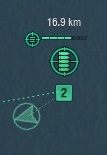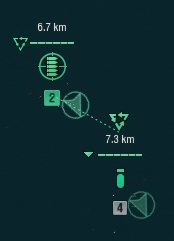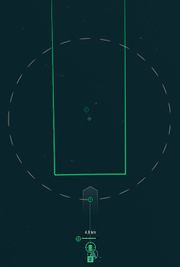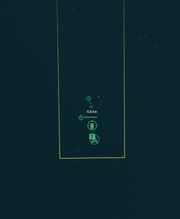Aircraft
| Revision as of 17:09, 28 November 2017 | Revision as of 22:09, 5 March 2018 | |||
| Line 1: | Line 1: | |||
| ? | + | {{Video|EJSDtPHZ1qk|width=375|Learn more about the different types of aircraft in World of Warships.}}{{AnnoWiki|content= | ||
| ? | When driving an aircraft carrier, you will most likely (with a few exceptions) have fighter aircraft at your disposal. Fighters are represented by an in-game icon consisting of stacked bullets. | + | [[File:Aircraft_modules_2.png|left]]'''Aircraft''' in World of Warships come in several variants; some launched from aircraft carriers, some launched from catapults aboard more traditional surface combatants. Planes launched from carriers are always under the control of the player; those launched from surface combatants are more automated and a player cannot issue specific commands to them once launched. Each type of plane has a unique role in the overall scope of aerial combat as it plays out in battle.}} | |
| + | ||||
| + | __TOC____NOEDITSECTION__ | |||
| + | ||||
| + | = Basics = | |||
| + | ||||
| + | == Controls == | |||
| + | ||||
| + | == Icons == | |||
| + | ||||
| + | == Minimap View versus Main UI View == | |||
| + | ||||
| + | = Carrier-Launched Aircraft = | |||
| + | ||||
| + | == Fighters == | |||
| + | [[File:Fighter_Squadron.png|frameless|left|link=]]When driving an aircraft carrier, you will most likely (with a few exceptions) have fighter aircraft at your disposal. Fighters are represented by | |||
| + | an in-game icon consisting of stacked bullets. | |||
| {| class="wikitable" | {| class="wikitable" | |||
| Line 31: | Line 47: | |||
| While being attacked by fighters, an enemy bomber squadron's accuracy is significantly affected. Depending on whether it is a dive bomber or torpedo bomber squadron, the dispersion indicators for the affected squadrons will be roughly twice as large, meaning it will be much harder for the enemy squadron to accurately place ordnance. This accuracy effect only lasts while the enemy squadron is under active attack. It does not apply until a fighter squadron has reached and engaged an enemy squadron, and the effect will end if you disengage the attack. It can be an effective tactic to target bomber squadrons which have not yet dropped their ordnance in order to mitigate the potential damage to ships in your fleet, as opposed to bombers which have already attacked and are returning to their host carrier. Note that strafing runs do not decrease accuracy, only direct engagements do. | While being attacked by fighters, an enemy bomber squadron's accuracy is significantly affected. Depending on whether it is a dive bomber or torpedo bomber squadron, the dispersion indicators for the affected squadrons will be roughly twice as large, meaning it will be much harder for the enemy squadron to accurately place ordnance. This accuracy effect only lasts while the enemy squadron is under active attack. It does not apply until a fighter squadron has reached and engaged an enemy squadron, and the effect will end if you disengage the attack. It can be an effective tactic to target bomber squadrons which have not yet dropped their ordnance in order to mitigate the potential damage to ships in your fleet, as opposed to bombers which have already attacked and are returning to their host carrier. Note that strafing runs do not decrease accuracy, only direct engagements do. | |||
| ? | == Guarding Squadrons == | + | === Guarding Squadrons === | |
| Fighters can be set to guard friendly squadrons by selecting a fighter squadron, and then Left-click on a friendly squad you wish to guard. Fighters will automatically fly with the guarded squadron for as long as they are assigned to guard it. If the guarded squadron is attacked, the fighters will automatically engage the squadron attacking the guarded friendly squadron. If the guarded squadron is destroyed, the fighters will discontinue the attack on the enemy squadron that had been attacking the guarded squadron and will await further orders. You can assign your fighters to guard any allied aircraft squadron, even if they belong to another player on your team. You can even guard other fighter squadrons if you wish, though it's not usually beneficial to do so. | Fighters can be set to guard friendly squadrons by selecting a fighter squadron, and then Left-click on a friendly squad you wish to guard. Fighters will automatically fly with the guarded squadron for as long as they are assigned to guard it. If the guarded squadron is attacked, the fighters will automatically engage the squadron attacking the guarded friendly squadron. If the guarded squadron is destroyed, the fighters will discontinue the attack on the enemy squadron that had been attacking the guarded squadron and will await further orders. You can assign your fighters to guard any allied aircraft squadron, even if they belong to another player on your team. You can even guard other fighter squadrons if you wish, though it's not usually beneficial to do so. | |||
| Line 39: | Line 55: | |||
| [[File:Guarded squadron.jpg|frameless|Guarded Bombers]] | [[File:Guarded squadron.jpg|frameless|Guarded Bombers]] | |||
| ? | == Strafing == | + | === Strafing === | |
| Fighters have a special ability called strafing. It is a form of manually targeted attack which expends a significant portion of the fighter squadrons ammunition in a concentrated area. If successfully applied to areas where enemy aircraft squadrons are located, it can quickly reduce enemy squadron strength. However, if it misses it can be easily punishable by an enemy strafing run or making you lose significant distance on a chased squadron. | Fighters have a special ability called strafing. It is a form of manually targeted attack which expends a significant portion of the fighter squadrons ammunition in a concentrated area. If successfully applied to areas where enemy aircraft squadrons are located, it can quickly reduce enemy squadron strength. However, if it misses it can be easily punishable by an enemy strafing run or making you lose significant distance on a chased squadron. | |||
| Line 56: | Line 72: | |||
| [https://youtu.be/NxdkOtxbWsg?list=PLpIStK0V3nVFRCw6WrJgHcOqtkXojB6YN Strafing Tutorial] | [https://youtu.be/NxdkOtxbWsg?list=PLpIStK0V3nVFRCw6WrJgHcOqtkXojB6YN Strafing Tutorial] | |||
| ? | + | == Bombers == | ||
| ? | All aircraft carriers in World of Warships have at least some planes equipped to attack enemy surface ships (sometimes referred to as "strike planes"), whether they be dive bombers or torpedo bombers or a mix of the two. Strike planes perform similarly to fighters except that they cannot attack enemy planes and their payload is a one-time-use, meaning that once their bombs or torpedoes are launched, they must | + | All aircraft carriers in World of Warships have at least some planes equipped to attack enemy surface ships (sometimes referred to as "strike planes"), whether they be dive bombers or torpedo bombers or a mix of the two. Strike planes perform similarly to fighters except that they cannot attack enemy planes and their payload is a one-time-use, meaning that once their bombs or torpedoes are launched, they must return to their carrier in order to re-arm and attack again. Strike planes are almost universally slower than fighters while carrying their strike ordnance, but they gain a speed boost once their payload has been dropped. | |
| ? | == Torpedo Bombers == | + | === Torpedo Bombers === | |
| ? | [[File: | + | [[File:Torpedo_Squadron.png|frameless|left|link=]]Torpedo bombers are the preferred strike weapons of aircraft carriers, as they provide consistent damage against almost any enemy ship in a given match. There are two methods for attacking with torpedo bombers: | |
| ? | === Auto-Drop === | + | {{Video|OzJZ-76l4NI|width=375|Learn more about manual torpedo drops.}} | |
| + | ==== Auto-Drop ==== | |||
| Clicking an enemy target with the '''Left Mouse Button''' will order the torpedo bomber to perform an "auto-drop". In this method of attack, the game calculates where to drop the torpedoes for an optimum attack against the enemy target; however, this presumes that the target does not change course and speed. Attentive players will usually note the approach of enemy torpedo bombers and maneuver to avoid the incoming attack, throwing off the automatic aim. Additionally, "auto-drop" drops the torpedoes into the water rather far away from the target, making dodging easier since the torpedoes are spotted almost soon as they go into the water. Very few aircraft carrier captains rely on auto-dropping, since most players can figure out how to react within the long window that the torpedoes give them to dodge. '''This is the only attack method available to torpedo bombers launched by Tier IV and Tier V aircraft carriers.''' | Clicking an enemy target with the '''Left Mouse Button''' will order the torpedo bomber to perform an "auto-drop". In this method of attack, the game calculates where to drop the torpedoes for an optimum attack against the enemy target; however, this presumes that the target does not change course and speed. Attentive players will usually note the approach of enemy torpedo bombers and maneuver to avoid the incoming attack, throwing off the automatic aim. Additionally, "auto-drop" drops the torpedoes into the water rather far away from the target, making dodging easier since the torpedoes are spotted almost soon as they go into the water. Very few aircraft carrier captains rely on auto-dropping, since most players can figure out how to react within the long window that the torpedoes give them to dodge. '''This is the only attack method available to torpedo bombers launched by Tier IV and Tier V aircraft carriers.''' | |||
| ? | === Manual Drop === | + | ==== Manual Drop (Alternative Attack Mode) ==== | |
| ? | By holding down '''Alt''', captains can perform a "manual drop" which allows them to command the torpedo squadron to drop the torpedoes in a specific area. Unlike the auto-drop, manual drops require that they be aimed by the player, and dropping too close to a target can cause the torpedoes to fail to arm prior to striking home. Aerial torpedoes take between 3 and 3.5 seconds to arm and be able to detonate on their target, and compensating for that delay is what makes manual dropping difficult for new carrier captains: too close and the torpedoes won't do damage at all, too far away and the target will have a longer window to dodge the torpedoes. Finding the perfect distance to allow aerial torpedoes to arm shortly before hitting requires practice to master, '''but is only available to torpedo bombers on Tier VI aircraft carriers and higher'''. | + | By holding down '''Alt''' and then clicking the '''Left Mouse Button''', captains can perform a "manual drop" which allows them to command the torpedo squadron to drop the torpedoes in a specific area. Unlike the auto-drop, manual drops require that they be aimed by the player, and dropping too close to a target can cause the torpedoes to fail to arm prior to striking home. Aerial torpedoes take between 3 and 3.5 seconds to arm and be able to detonate on their target, and compensating for that delay is what makes manual dropping difficult for new carrier captains: too close and the torpedoes won't do damage at all, too far away and the target will have a longer window to dodge the torpedoes. Finding the perfect distance to allow aerial torpedoes to arm shortly before hitting requires practice to master, '''but is only available to torpedo bombers on Tier VI aircraft carriers and higher'''. | |
| ? | + | ==== Types of Aerial Torpedoes ==== | ||
| ? | === Types of Aerial Torpedoes === | + | ||
| There are two types of aerial torpedoes available in World of Warships. | There are two types of aerial torpedoes available in World of Warships. | |||
| Line 90: | Line 106: | |||
| {{Ship:Aerial Torpedo Data}} | {{Ship:Aerial Torpedo Data}} | |||
| ? | + | ==== Torpedo Drop Patterns ==== | ||
| ? | === Torpedo Drop Patterns === | + | ||
| The drop patterns of aerial torpedoes vary by nation and are sometimes unique to individual carriers. A table with images showing the available torpedo drop patterns is below. | The drop patterns of aerial torpedoes vary by nation and are sometimes unique to individual carriers. A table with images showing the available torpedo drop patterns is below. | |||
| {{Ship:Aerial Torpedo Drop Patterns}} | {{Ship:Aerial Torpedo Drop Patterns}} | |||
| + | === Dive Bombers === | |||
| + | [[File:HE Bomb Squadron.png|frameless|left|link=]]Dive bombers are the second type of strike plane, and they are a bit faster than torpedo bombers. Their service time (at least usually) is less than torpedo bombers, and they are a bit faster. There are usually more dive bombers on a carrier than torpedo bombers. On the Japanese side, dive bombers seem like a secondary weapon with their relatively small damage compared to torpedo planes (4,500 vs. 8,567). However, American dive bombers cause massive damage starting from Tier VI onwards. They use a 500-pound bomb — versus the Japanese 100 kg (220 pounds) — that deals about 3,000 max damage more. Starting from ''[[Lexington]]'' at Tier VIII, that number is even higher, at 10,800 with the 1,000-pound bomb. The large American bombs will be deal heavy damage to any ship they hit, provided they hit. That is the trade-off: American planes suffer from increased dispersion while the Japanese have tighter dispersion with less damage. Note that ''[[Enterprise]]'' and ''[[Graf Zeppelin]]'' are unique in that they have access to armor piercing bombs capable of doing tremendous damage to enemy battleships. | |||
| ? | + | Dive bombers are similar to torpedo bombers in almost every way. They can be auto-dropped, which is recommended most of the time since leading dive-bomber squads can be a serious waste of time. Alternatively, they can be manual-dropped and have tighter dispersion. Unlike torpedo bombers, dive bomber hits are based on random chance within the target area. Even if you are almost dead-on in your aim, you can sometimes miss. '''Tier IV and Tier V aircraft carriers can only auto-drop dive bombers.''' | ||
| + | ||||
| + | ==== Auto-Drop ==== | |||
| + | ||||
| + | ==== Manual Drop (Alternative Attack Mode) ==== | |||
| + | ||||
| + | ==== Types of Bombs ==== | |||
| + | There are two types of bombs available in World of Warships. | |||
| + | ||||
| + | {| class="wikitable" style="text-align:center; margin-left: auto; margin-right: auto; border: none; width:815px" | |||
| + | |- | |||
| + | ! style="vertical-align:middle; width: 150px" | Icon | |||
| + | ! style="vertical-align:middle; width: 465px" | Description | |||
| + | ! style="vertical-align:middle; width: 200px" | Nation | |||
| + | |- | |||
| + | | style="vertical-align:middle" | [[File:HE Bomb Squadron.png]] | |||
| + | | style="vertical-align:middle" | '''High Explosive Bombers''' drop bombs packed with large amounts of high explosive, with the primary intent of inflicting high amounts of module damage and set fires. These bombs are capable of inflicting damage against any class of enemy ship: destroyer, cruiser, battleship, or aircraft carrier. | |||
| + | | style="vertical-align:middle" | [[File:Wows_flag_Japan.png|50 px|frameless|link=Ship:Ships_of_Japan]] [[File:Wows_flag_USA.png|50 px|frameless|link=Ship:Ships_of_U.S.A.]] [[File:Wows flag Germany.png|50 px|frameless|link=Ship:Ships_of_Germany]] | |||
| + | |- style="background: #ffd6c1;" | |||
| + | | style="vertical-align:middle" | [[File:AP Bomb Squadron.png]] | |||
| + | | style="vertical-align:middle" | '''Armor-Piercing Bombers''' drop bombs that are fused specifically to penetrate the extra layers of deck armor found on battleships, as well as some cruisers and aircraft carriers. While these bombs are capable of inflicting damage against any class of ship, the larger and heavier the ship, the more damage they will inflict (i.e. they do significantly less damage against destroyers than they do against battleships). | |||
| + | | style="vertical-align:middle" | [[File:Wows_flag_USA.png|50 px|frameless|link=Ship:Ships_of_U.S.A.]] [[File:Wows flag Germany.png|50 px|frameless|link=Ship:Ships_of_Germany]] | |||
| + | |} | |||
| + | ||||
| + | {{Ship:Aerial Bomb Data}} | |||
| + | ||||
| + | ==== Bomb Drop Circles ==== | |||
| + | ||||
| + | = Catapult-Launched Aircraft = | |||
| + | ||||
| + | == Catapult Fighter == | |||
| + | [[File:Consumable_PCY004_Fighter.png|frameless|left|link=]] | |||
| ? | ||||
| ? | ||||
| ? | ||||
| + | == Spotting Aircraft == | |||
| + | [[File:Consumable_PCY005_Spotter.png|frameless|left|link=]] | |||
| [[Category:World of Warships]] | [[Category:World of Warships]] | |||
Revision as of 22:09, 5 March 2018
(link)
Learn more about the different types of aircraft in World of Warships.Basics
Controls
Icons
Minimap View versus Main UI View
Carrier-Launched Aircraft
Fighters

an in-game icon consisting of stacked bullets.
| US Fighter Squadron | Japanese Fighter Squadron |
|---|---|
| |

|
The bullets will be either solid or outlined, where the solid bullets represent remaining ammunition for that fighter squad. After a fighter squad has spent all of its ammunition, it must return to the carrier to re-arm.
The number of fighters in a squadron may vary by nationality. US carriers use 6-aircraft squadrons (exception: Premium Carrier "Saipan" which uses fighter squadrons of 3 planes but got up to 3 squadrons active), while Japanese carriers use 4-aircraft squadrons. The number of fighters in a squadron are represented by a set of bars across the top of the squad icon (green for friendly, red for hostile). Solid colour bars (green or red) indicate fighters, whereas shaded transparent bars represent missing fighters which have either been shot down or where there were not enough aircraft reserves on the carrier to form a complete squadron. The Air Supremacy commander skill will increase the fighters per squadron by 1, making 7 (4 for "Saipan") for the US and 5 for the Japanese.
To engage a fighter squadron, first select the squadron to use for attack by pressing the assigned squadron number. You can select multiple squadrons by holding down CTRL while you select the squadrons. Once the squadron(s) are selected, left-click on the enemy aircraft squadron you wish to attack to plot an intercept course directly to the target and have the fighters automatically engage once in range. You may also optionally plot a series of waypoints with the selected squadrons before clicking on the target enemy squadron. This may be useful to avoid enemy ship-based Anti-Aircraft fire, or perhaps to avoid other enemy aircraft squadrons you do not wish to engage.
Any enemy aircraft you shoot down will be recorded, and a ribbon will be displayed for each downed plane. However, if you lose planes you will not be notified unless the entire squadron has been shot down, at least verbally.
Fighters vs. Fighters
If you attack enemy fighters, all affected squadrons (one or more of your squadrons plus the targeted enemy squadron(s)) will stay in the same location once engaged. This can be used to your advantage if you are engaged within the Anti-Air screen of a nearby friendly ship, or conversely detrimental if you're engaged over enemy ships. Your squadron will continue the attack until the enemy squadron under attack is destroyed or it disengages from the fight. You can disengage from a fight by giving your squadron(s) a new waypoint or a different target. Note that the enemy fighter squadron will still be attacking your squadron if you disengage, even if you choose to engage a different target, until otherwise directed by the enemy fighter squadron's captain. This can be troubling if your planes have run out of ammo, leaving them about as defenseless as bombers.
Fighters vs. Bombers
If you attack enemy bombers, all the affected squadrons will first intercept the target squadron and then cause the squadron under attack to slow down slightly. Bombers cannot target fighters, but they can defend themselves if they have the capability, so it is possible to take losses when fighting enemy bombers. The enemy bombers will continue on their course, or adjust course if directed by their captain, and your fighter squadrons will automatically follow and continue the engagement until the enemy squadron is destroyed, the fighters' ammunition is depleted, or the fighters are given new orders.
While being attacked by fighters, an enemy bomber squadron's accuracy is significantly affected. Depending on whether it is a dive bomber or torpedo bomber squadron, the dispersion indicators for the affected squadrons will be roughly twice as large, meaning it will be much harder for the enemy squadron to accurately place ordnance. This accuracy effect only lasts while the enemy squadron is under active attack. It does not apply until a fighter squadron has reached and engaged an enemy squadron, and the effect will end if you disengage the attack. It can be an effective tactic to target bomber squadrons which have not yet dropped their ordnance in order to mitigate the potential damage to ships in your fleet, as opposed to bombers which have already attacked and are returning to their host carrier. Note that strafing runs do not decrease accuracy, only direct engagements do.
Guarding Squadrons
Fighters can be set to guard friendly squadrons by selecting a fighter squadron, and then Left-click on a friendly squad you wish to guard. Fighters will automatically fly with the guarded squadron for as long as they are assigned to guard it. If the guarded squadron is attacked, the fighters will automatically engage the squadron attacking the guarded friendly squadron. If the guarded squadron is destroyed, the fighters will discontinue the attack on the enemy squadron that had been attacking the guarded squadron and will await further orders. You can assign your fighters to guard any allied aircraft squadron, even if they belong to another player on your team. You can even guard other fighter squadrons if you wish, though it's not usually beneficial to do so.
You can assign other strike planes to follow a squad, but they will not attack the leading squad's target. Instead, you have to manually assign targets.
Strafing
Fighters have a special ability called strafing. It is a form of manually targeted attack which expends a significant portion of the fighter squadrons ammunition in a concentrated area. If successfully applied to areas where enemy aircraft squadrons are located, it can quickly reduce enemy squadron strength. However, if it misses it can be easily punishable by an enemy strafing run or making you lose significant distance on a chased squadron.
The strafing ability is applied by holding down the ALT key for a selected squadron(s) and moving the aiming locator to a desired position. Once you have selected a position for a strafing run (as indicated by the green band), you can order the strafing run by left-clicking at the desired location. As with all manually aimed aircraft abilities, you are free to give the squadron different orders until the squadron enters the engagement area of the selected ability identified by the dashed grey circular outline around the strafing zone. Once in the engagement zone, the strafing area will change colour from green to yellow indicating that the squadron is committed to performing the strafing attack. New orders can be given to the squadron while it is performing the strafing run, but the affected squadron will not respond to any commands until the strafing run is complete.
To use this ability successfully you may need to predict where enemy aircraft will be located by the time your fighter squadrons enter the strafing engagement zone. If the enemy aircraft leave the strafing zone before your fighters begin their strafing run, the enemy aircraft won't be affected by the strafe and your fighters will have wasted their ammunition. Enemy strike planes can gain a significant lead if you poorly place your strafing runs, and enemy fighters can potentially line up a counter-strafe that will probably be devastating on your planes. Please note that the strafing run does not decrease the accuracy of enemy strike planes, and sometimes attacking directly is more beneficial to your teammates. It is important to correctly determine where you start your strafing run. If you begin the strafing run too soon, you might miss the target completely. If the strafing run is started too far away, the enemy squadron will have ample time to leave the engagement area.
Only aircraft carriers Tier VI and above can engage in strafing runs.
Bombers
All aircraft carriers in World of Warships have at least some planes equipped to attack enemy surface ships (sometimes referred to as "strike planes"), whether they be dive bombers or torpedo bombers or a mix of the two. Strike planes perform similarly to fighters except that they cannot attack enemy planes and their payload is a one-time-use, meaning that once their bombs or torpedoes are launched, they must return to their carrier in order to re-arm and attack again. Strike planes are almost universally slower than fighters while carrying their strike ordnance, but they gain a speed boost once their payload has been dropped.
Torpedo Bombers

(link)
Learn more about manual torpedo drops.Auto-Drop
Clicking an enemy target with the Left Mouse Button will order the torpedo bomber to perform an "auto-drop". In this method of attack, the game calculates where to drop the torpedoes for an optimum attack against the enemy target; however, this presumes that the target does not change course and speed. Attentive players will usually note the approach of enemy torpedo bombers and maneuver to avoid the incoming attack, throwing off the automatic aim. Additionally, "auto-drop" drops the torpedoes into the water rather far away from the target, making dodging easier since the torpedoes are spotted almost soon as they go into the water. Very few aircraft carrier captains rely on auto-dropping, since most players can figure out how to react within the long window that the torpedoes give them to dodge. This is the only attack method available to torpedo bombers launched by Tier IV and Tier V aircraft carriers.
Manual Drop (Alternative Attack Mode)
By holding down Alt and then clicking the Left Mouse Button, captains can perform a "manual drop" which allows them to command the torpedo squadron to drop the torpedoes in a specific area. Unlike the auto-drop, manual drops require that they be aimed by the player, and dropping too close to a target can cause the torpedoes to fail to arm prior to striking home. Aerial torpedoes take between 3 and 3.5 seconds to arm and be able to detonate on their target, and compensating for that delay is what makes manual dropping difficult for new carrier captains: too close and the torpedoes won't do damage at all, too far away and the target will have a longer window to dodge the torpedoes. Finding the perfect distance to allow aerial torpedoes to arm shortly before hitting requires practice to master, but is only available to torpedo bombers on Tier VI aircraft carriers and higher.
Types of Aerial Torpedoes
There are two types of aerial torpedoes available in World of Warships.
| Nation | Torpedo Type | Range | Speed | Damage | Arming Distance | Detection Range | Flood Chance | Deployed Aboard |
|---|---|---|---|---|---|---|---|---|
| |
Torpedo Mk.7D | 3.0 km | 35 knots | 3,500 | 282 m | 1.1 km | 33% | |
| |
Torpedo Mk.7 | 3.0 km | 35 knots | 5,567 | 313 m | 1.1 km | 45% | |
| |
Torpedo Mk.7 | 3.0 km | 35 knots | 5,567 | 344 m | 1.1 km | 45% | |
| |
Torpedo Mk.7 mod. 1 | 3.0 km | 43 knots | 3,767 | 577 m | 1.4 km | 37% | |
| |
Torpedo Mk.7 | 3.0 km | 35 knots | 4,667 | 344 m | 1.1 km | 40% | |
| |
Torpedo Mk.13-2 | 3.5 km | 35 knots | 6,467 | 376 m | 1.5 km | 52% | |
| |
Torpedo Mk.13-2 | 3.5 km | 35 knots | 6,467 | 423 m | 1.6 km | 52% | |
| |
Torpedo Mk.13-2 Mod 1 | 3.5 km | 43 knots | 5,067 | 577 m | 1.9 km | 42% | |
| |
Torpedo Mk.13-2 Mod 1 | 3.5 km | 43 knots | 3,633 | 577 m | 1.9 km | 29% | |
| |
Torpedo Mk.13-2 | 3.5 km | 35 knots | 6,467 | 470 m | 1.6 km | 52% | |
| |
Torpedo Mk.7 mod. 1 | 4.0 km | 35 knots | 5,067 | 470 m | 1.1 km | 42% | |
| |
Torpedo Mk.7 mod.1 | 4.0 km | 35 knots | 5,067 | 517 m | 1.1 km | 42% | |
| |
Torpedo Mk.13-2 Mod 2 | 3.5 km | 43 knots | 6,433 | 577 m | 1.9 km | 53% | |
| |
Torpedo Mk.7D | 4.0 km | 35 knots | 4,233 | 517 m | 1.1 km | 33% | |
| |
Torpedo Mk.25 | 4.0 km | 35 knots | 6,133 | 470 m | 1.6 km | 51% | |
| |
Type 91 mod. 0 | 3.0 km | 40 knots | 5,800 | 322 m | 1.3 km | 32% | |
| |
Type 91 mod. 1 | 3.0 km | 50 knots | 5,400 | 447 m | 1.3 km | 30% | |
| |
Type 91 mod. 1 | 5.0 km | 50 knots | 5,400 | 806 m | 1.3 km | 30% | |
| |
Type 91 mod. 3 | 5.0 km | 50 knots | 7,233 | 537 m | 1.3 km | 40% | |
| |
Type 99 No. 80 Mk. 5 | 6.0 km | 50 knots | 9,333 | 671 m | 1.6 km | 40% | |
| |
Type 91 mod. 7 | 6.0 km | 50 knots | 9,333 | 671 m | 1.6 km | 40% | |
| |
Type 91 mod. 8 | 6.0 km | 50 knots | 7,500 | 671 m | 1.6 km | 41% | |
| |
Type 5 | 2.2 km | 35 knots | 2,767 | 376 m | 1.4 km | 17% | |
| |
Type 5 | 2.2 km | 35 knots | 2,767 | 423 m | 1.4 km | 17% | |
| |
TAN-12B | 6.0 km | 41 knots | 3,333 | 661 m | 1.3 km | 28% | |
| |
TAN-12 | 6.0 km | 41 knots | 3,833 | 661 m | 1.3 km | 33% | |
| |
45-36AN-V | 6.0 km | 41 knots | 4,667 | 826 m | 1.3 km | 40% | |
| |
45-36AN-A | 6.0 km | 41 knots | 4,533 | 716 m | 1.3 km | 39% | |
| |
45-36AN-B | 6.0 km | 41 knots | 5,200 | 826 m | 1.3 km | 45% | |
| |
F5c | 2.0 km | 50 knots | 3,000 | 403 m | 1.3 km | 25% | |
| |
F5 | 2.0 km | 50 knots | 3,600 | 403 m | 1.3 km | 31% | |
| |
F5d | 2.5 km | 52 knots | 4,067 | 489 m | 1.3 km | 34% | |
| |
LT F5a | 6.0 km | 32 knots | 4,200 | 387 m | 1.1 km | 23% | |
| |
LT F5b | 6.0 km | 35 knots | 5,333 | 470 m | 1.3 km | 29% | |
| |
BT 1000 | 3.0 km | 55 knots | 4,533 | 591 m | 1.4 km | 39% | |
| |
F5f | 6.0 km | 35 knots | 4,767 | 470 m | 1.3 km | 27% | |
| |
Mark VIII | 2.4 km | 35 knots | 5,200 | 282 m | 1.1 km | 45% | |
| |
Mark VIII | 2.4 km | 35 knots | 5,200 | 329 m | 1.1 km | 45% | |
| |
Mark XII | 2.4 km | 35 knots | 5,933 | 376 m | 1.2 km | 51% | |
| |
Mark VIII | 2.4 km | 35 knots | 5,200 | 329 m | 1.1 km | 45% | |
| |
Mark XII | 2.4 km | 35 knots | 5,933 | 407 m | 1.2 km | 51% | |
| |
Mark XV | 2.4 km | 35 knots | 5,933 | 438 m | 1.3 km | 63% | |
| |
Mark XII | 2.4 km | 35 knots | 5,200 | 329 m | 1.1 km | 45% | |
| |
Mark XVII | 2.4 km | 35 knots | 5,933 | 470 m | 1.3 km | 51% | |
| |
Mark XIX | 2.4 km | 35 knots | 6,533 | 470 m | 1.3 km | 56% | |
| |
Mark XVII | 2.4 km | 35 knots | 5,933 | 493 m | 1.3 km | 51% | |
| |
Mark XVIII | 2.4 km | 40 knots | 7,800 | 564 m | 1.3 km | 66% | |
| |
450 mm F200 | 3.5 km | 30 knots | 7,133 | 403 m | 1.3 km | 61% | |
Torpedo Drop Patterns
The drop patterns of aerial torpedoes vary by nation and are sometimes unique to individual carriers. A table with images showing the available torpedo drop patterns is below.
This page refers to the pre-0.8.0 torpedo squadrons. It is obsolete.
| Image | Nation | Ships | Notes |
|---|---|---|---|
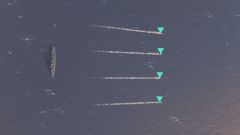
|
|
Hosho, Zuiho, Ryujo, Hiryu, Shokaku, Taiho, Hakuryu | The Japanese manual drop is special, since it converges on the end-point of the spread. This allows for potential pincer-torpedo attacks, and landing one is also something hard to master. Most captains focus on giving minimal reaction time to enemy targets; however, some will attempt a long-ranged "snipe" with torpedoes that can potentially be deadly. Such long-ranged snipes work best on disabled ships, such enemies with their engine or rudder incapacitated, who are ramming into an allied ship, or that have run aground. |
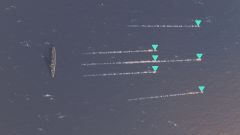
|
|
Kaga | Kaga’s torpedo drop is unique in two ways. One, it is made up of two lines of torpedoes: a wide "forward" line, and a narrow "trailing" one. Secondly, she boasts the fastest-moving aerial torpedoes in the game, making avoiding damage from a good drop exceedingly difficult. |
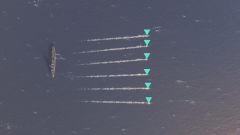
|
|
Langley, Bogue, Independence, Ranger, Lexington, Essex, Midway | The American manual drop is almost the antithesis of the Japanese one: wider, with narrower gaps between the torpedoes that make it more difficult for ships to dodge all of them. It also does not narrow as the Japanese spread does, with all six fish traveling in a straight line — parallel to those on either side — after being dropped. |
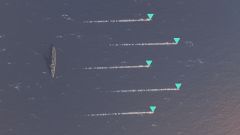
|
|
Enterprise | Enterprise’s torpedo drop pattern resembles a "W", and is challenging to use on anything besides large capital ships that will have difficulty dodging all of her torpedoes. In order to hit smaller and more maneuverable targets such as destroyers, captains will have to master the art of manually dropping each squadron on opposite sides of the enemy ship. |
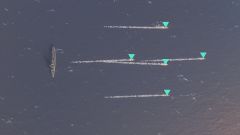
|
|
Graf Zeppelin | The torpedo drop patter of Graf Zeppelin is uniquely suited to punishing ships that aren't maneuvering against her torpedo bombers. With three torpedoes lined up in the center, one right after the other, a practiced captain can easily put down a drop to ensure that a battleship eats at least those three fish and probably one of the flankers as well. |
Dive Bombers

Dive bombers are similar to torpedo bombers in almost every way. They can be auto-dropped, which is recommended most of the time since leading dive-bomber squads can be a serious waste of time. Alternatively, they can be manual-dropped and have tighter dispersion. Unlike torpedo bombers, dive bomber hits are based on random chance within the target area. Even if you are almost dead-on in your aim, you can sometimes miss. Tier IV and Tier V aircraft carriers can only auto-drop dive bombers.
Auto-Drop
Manual Drop (Alternative Attack Mode)
Types of Bombs
There are two types of bombs available in World of Warships.
| Nation | Bomb Type | Damage | Armor Penetrated | Fire Chance | Deployed Aboard |
|---|---|---|---|---|---|
| |
AN-M64 | 7,300 | 42mm | 41% | |
| |
AN-M64 | 7,300 | 53mm | 46% | |
| |
AN-M65 | 9,200 | 53mm | 52% | |
| |
AN-M62 | 5,600 | 42mm | 32% | |
| |
AN-M62 | 4,900 | 244mm | N/A | |
| |
AN-M60 | 3,600 | 328mm | N/A | |
| |
AN-M66 | 11,200 | 67mm | 64% | |
| |
AN-M633 | 5,400 | 42mm | 31% | |
| |
AN-M56A1 | 16,000 | 85mm | 91% | |
| |
Type 99 No. 25 mod. 2 | 2,500 | 174mm | N/A | |
| |
Type 99 No. 25 mod. 1 | 4,600 | 174mm | N/A | |
| |
Type 3 No. 25 Mk. 4 | 5,100 | 228mm | N/A | |
| |
Type 2 No. 50 Mk. 1 | 6,200 | 283mm | N/A | |
| |
Type 90 No. 50 Mk. 2 | 8,800 | 55mm | 50% | |
| |
Type 99 No. 80 Mk. 5 | 6,800 | 351mm | N/A | |
| |
FAB-100 | 6,100 | 32mm | 35% | |
| |
FAB-250 | 6,100 | 32mm | 35% | |
| |
FAB-500 | 8,700 | 55mm | 49% | |
| |
FAB-500B | 7,500 | 55mm | 43% | |
| |
PC 500a | 4,000 | 149mm | N/A | |
| |
SC 1000 | 12,200 | 69mm | 69% | |
| |
PC 500c | 7,000 | 227mm | N/A | |
| |
PD 500 | 5,800 | 344mm | N/A | |
| |
PC 500 | 7,800 | 256mm | N/A | |
| |
PC 1000 | 8,800 | 331mm | N/A | |
| |
SC 1000 | 11,100 | 69mm | 63% | |
| |
40 lb. G.P. Bomb | 2,300 | 18mm | 8.7% | |
| |
40 lb. G.P. Bomb | 2,300 | 19mm | 9% | |
| |
250 lb. G.P. Bomb | 4,700 | 33mm | 27% | |
| |
250 lb G.P. Bomb Mk.I | 5,600 | 33mm | 32% | |
| |
250 lb G.P. Bomb Mk.I | 4,700 | 33mm | 27% | |
| |
500 lb. G.P. Bomb | 6,400 | 41mm | 36% | |
| |
500 lb. G.P. Bomb | 4,300 | 109mm | N/A | |
| |
500 lb G.P. Bomb Mk.I | 6,400 | 52mm | 36% | |
| |
150-kg G.P. Mle 1930 | 3,600 | 219mm | N/A | |
| |
500-kg G.P. Mle 1930 | 6,100 | 32mm | 35% | |
Bomb Drop Circles
Catapult-Launched Aircraft
Catapult Fighter

Spotting Aircraft


